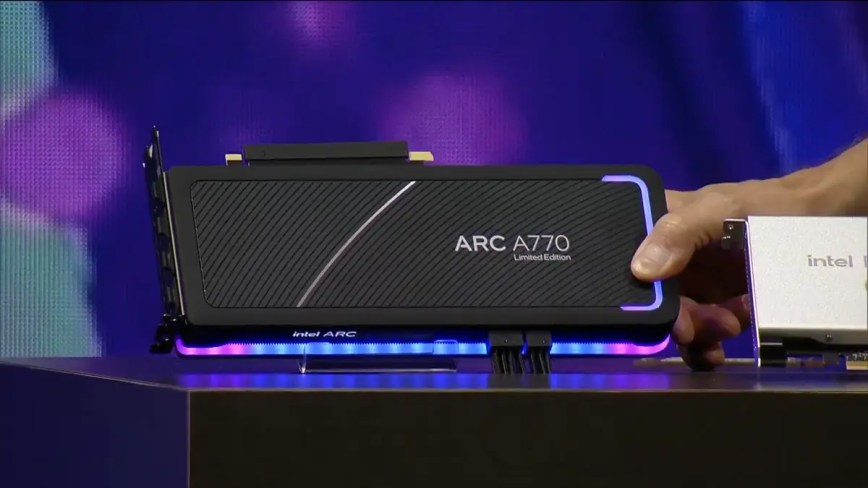For way too long, two parties have been fighting over graphics cards. We’ve got Nvidia’s GeForce RTX GPUs. While AMD’s Radeon lineup has been around for a long time. In order to keep both companies in check, we desperately need a third party. With the launch of its Arc GPUs, Intel aims to play that role.
Do you think Intel’s Arc GPUs are good enough?
1. GPUs from Intel are really cheap

One of the biggest reasons to choose Intel GPUs over Nvidia or AMD GPUs is their price. Cheap as hell.
For just $349, you can get Intel’s flagship GPU, the Arc A770. Alternatively, you can get the lower-end Arc A750 for just $249. A low-end card, the Arc A380, costs $139. It’s not high-end, but the A770 can rival a Nvidia RTX 3060 Ti. However, if you find a deal, they’re even cheaper.
That’s a breath of fresh air. Every year, graphics cards get more expensive. Two years later, in 2022, Nvidia launched the RTX 4080 with an MSRP of $1,200, just two years after the RTX 3080. Prices for the RTX 3090 started at $1,500, and for the RTX 4090, at $1,600. The GPU manufacturers bump their prices substantially because they’re confident enough that people will buy them anyway.
That’s why we’re excited to see Intel offer some more premium cards once it has a few more premium cards to show off, bucking the trend and making its cards intentionally affordable. Currently, it doesn’t have anything that can compete with these premium cards, but that could change.
In addition, Intel is trying to establish itself in a market dominated by two companies. Intel’s CPUs are a behemoth, but graphics cards are a new territory. Making your products cheaper than your competitors is the best way to get people to consider them? If Intel starts pushing bleeding-edge, top-performance GPUs and gains some brand recognition in the GPU space, it might not be able to keep up its low price strategy. I’d be happy if it did.
In any case, AMD and Nvidia have to compete harder, possibly by lowering their own prices, as a lower-priced competitor will force them to lower their own prices. Ultimately, buyers win.
2. It’s getting faster and faster for Intel’s Arc GPUs

Additionally, Intel is still getting experience as a GPU maker, so you might want to consider an Intel GPU. Having said that, Intel will make better drivers as the card matures, which will, in turn, squeeze more performance out of the hardware. There’s a lot of great hardware in Intel GPUs, but its drivers don’t use it well. Essentially, the cards will keep getting better as they change.
We’ve already done this. It’s worth running benchmarks and performance updates again after Intel Arc driver updates because they improve performance so much. The new Intel cards are getting better as time goes on, and what was previously inconsistent performance is turning around. As the card matures, we expect this to keep happening.
RTX 4090s or similar cards can match that performance, but it’s not enough. That’ll only happen if Intel releases a flagship GPU. Even with that, they’re able to punch above their weight.
3. Most features in other GPUs are supported by Intel Arc GPUs

Another thing to consider is that you don’t lose anything compared to other GPUs. The Intel Arc GPUs are pretty similar to other GPUs, despite their relative newness. Drivers aren’t the only thing we’re talking about.
Upscaling graphics? Intel XeSS fills that hole left by DLSS. How about ray tracing? Yes, it’s there too. Neither feature is as polished as those in Nvidia/AMD GPUs, but Intel is polishing things up over time – and in future generations, it’ll even add those things the card lacks. These GPUs will be just as good as or better than Nvidia/AMD, even if it doesn’t get up to speed this generation. There’s a lot of hope for Intel here.
4. AMD & Nvidia GPUs aren’t the only ones

Finally, but most importantly, Intel is a newcomer, and its success, or lack thereof, will likely have a big impact on how the GPU market develops.
Since years, Nvidia and AMD have been competing. The third party will eventually force a shift in the market, making both GPU giants compete even harder if enough people buy it. It might be able to do that by adding more features or lowering its prices/profits. Some serious competition would help Nvidia avoid pricing its newer cards over $1,000. Overall, it’s a win-win for everyone, but mostly for consumers.
Give Team Blue a try
You might have a hard time trying new things if you’re brand loyal. If you’re looking for a cheap GPU, Intel has worked on it for years, so maybe check it out.

